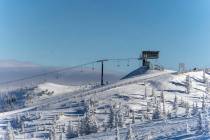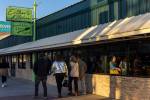Pruning can help with disciplining plants
Discipline is required for any young, growing, thing -- be it a child, puppy or plant. You have to train them all, so they'll develop to your best expectations. In the case of plants, pruning becomes their discipline. You guide plants to conform to the shape and appearance you desire.
When dealing with plants, they are a lot like us: different in many ways. Translated, there is no exact plan to fit all situations. The science of pruning means being aware of how light affects growth, and how a plant's structure develops over time. The art lies in pruning so balance of growth and productivity are aesthetically pleasing to you.
Pruning is a year-round responsibility that starts the moment you plant a tree or shrub, but only prune as much as necessary. To make the task easier, choose plants whose mature size and form meets your needs without shearing and shaping. There's no point in planting an 8-foot-tall shrub under a 4-foot-high window. You'll spend the rest of your life pruning it.
Always know why you are making each cut. I dare say half the pruning we do is done needlessly or incorrectly, but all cuts are perfect once you've made them. Here are some reasons to prune:
• To modify direction of a plant's growth;
• To reduce the total height and/or width of a plant;
• To train the plant to a specific form or shape;
• To protect the health of the plant;
• To remove unproductive, weak and crowded branches;
• To increase quality or quantity of flower and fruit production;
• To improve visibility, making entryways and street intersections safer.
A good gardener is able to prune so that when finished you can't tell if the plants were pruned. Here are some basic pruning techniques used for shrubs. Some plants require more of one method, but you need to use a combination of all these methods.
• Pinching is removing terminal buds. Pinched plants keep their natural shape and appear graceful. Pinching off fading flower buds before they set seed also is another way to divert energy to the remaining buds, resulting in more and larger flowers.
Actually, pinching is where the saying "green thumb" became part of gardening slang. A person constantly pinching back shrubs ends up with a green thumb from the green in plants.
• Thinning is removing entire branches for a more open look. Hormones that distribute among the remaining branches cause them to grow longer and fuller. If wind is a problem, thinning branches will help reduce the plant's wind load. Thinning also opens up a dense tree so grass will grow under its canopy. Thin out the oldest and tallest stems first to allow vigorous development.
• Heading back involves removing terminal growth of branches by cutting back to a bud. This stimulates new shoot growth below the cut, making plants denser, but this can become a problem. Repeated heading back with no thinning cuts results in a top-heavy plant that reduces sunlight and loss of foliage inside the plant canopy.
Let me digress a moment. If you never remove the dominant bud at the tip of each stem, it will continue extending and bushes become gangly. There is a reason for the gangly look. There are dormant buds above each leaf along the stem. They remain subservient to the dominant bud, but remove the lead bud and a war begins. All those dormant buds now want to become the leader. This is just what the doctor ordered -- a thicker, fuller bush.
• Suckers are willowy, water-type sprouts coming from roots below a bud union or graft at the base of the tree, and that's bad. Remove them while they're small or they will consume your desired plant. Suckers are more prevalent on roses and fruit trees.
• Deadheading is the removal of spent flowers on plants such as roses before they set seeds. By removing old flowers, the extra energy goes into producing more and larger flowers.
You can do light corrective pruning any time of the year and will reduce the need for severe pruning, which might weaken plants and reduce their natural beauty. But when heavy pruning becomes necessary, do it!
Pruning shrubs is an ongoing task. It is not a yearly pilgrimage to the yard with the loppers and saw to do major surgery. If you prune right, hand nippers will be the only tool you'll need. In fact, you want nippers hanging on your waist every time you enter the yard. Notice, professional landscape personnel always have nippers hanging from their waist. They nip many problems with a simple snip.
As always, get rid of any dead, diseased, insect-infested wood you see in any bush. If in doubt, bend the twig. If it snaps, assume that it's dead and prune it out.
Never leave a stub or part of a limb extending from another branch. A plant cannot heal over a stub, so it is unable to seal off and it will glare at you for eternity or until you prune it out.
If you planted a shrub for its flowering habits, take the guesswork out of when to prune by pruning after bloom. For example, if you prune out last year's twiggy grow of flowering plants like pyracantha before bloom, you end up removing most of the flowering wood.
Prune all hedges so the bottom of the hedge is wider than the top. This enables light to reach the lower branches, so the plant retains its foliage from top to bottom. A hedge wider at the top shades the lower branches resulting in exposed trunks, which are not a pleasant sight.
Recycle your Christmas tree: Tuesday is the last day you can recycle your Christmas tree. There are 19 drop sites across the valley receiving trees from 8 a.m. to 5 p.m. For a site near you, go to www.springspreserve.org or call 822-7754. If leaving a message, leave your nearest major cross streets and I will let you know the nearest site.
Become a desert gardener: Nevada Cooperative Extension's master gardeners are offering three classes on Wednesdays at 7 p.m. at the extension learning center at 8050 S. Maryland Parkway. On Wednesday, Elaine Fagin will cover soil preparation, when to plant, planting techniques, feeding and caring for your vegetables so you will have a successful harvest. To reserve a seat for this class, call 257-5555.
Rose pruning demonstration: Learn how to care for your roses by attending a demonstration Jan. 19 from 9 a.m. to 2 p.m. at 1112 Oak Tree Lane. For directions, call 646-6048.
Fruit tree pruning demo: I will demonstrate proper pruning techniques for fruit trees at 8:30 a.m. Jan. 26 at the Gardens at the Springs Preserve, 333 S. Valley View Blvd. Reserve your seat by calling 822-7700.
Linn Mills writes a garden column every Thursday. You can reach him at linn.mills@springspreserve.org or at the Gardens at the Springs Preserve at 822-7754.























